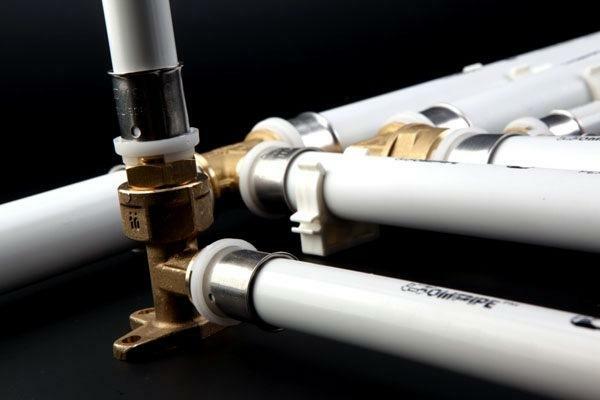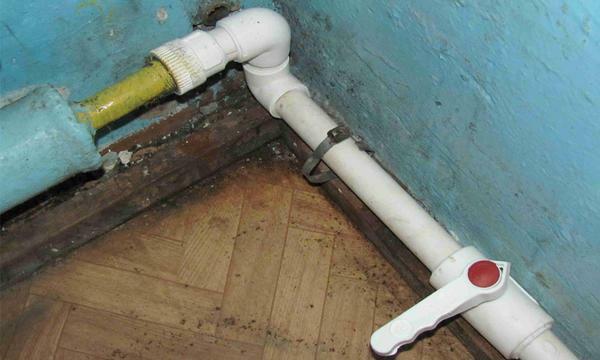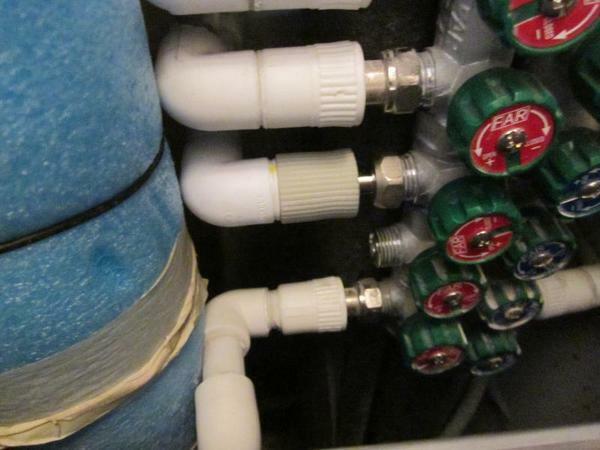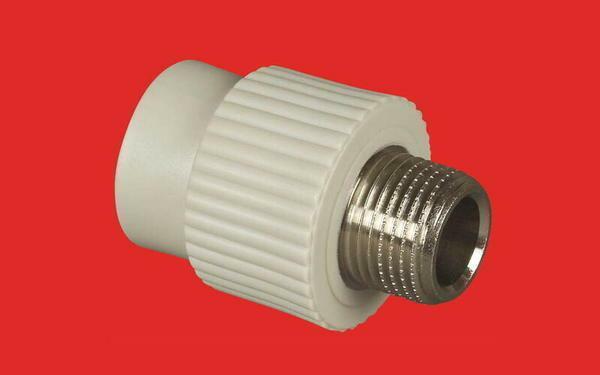 Before bonding the metal and plastic pipes, they must be pre-prepared to avoid a poor connection Today, the pipes are connected by two methods: flanged and threaded methods. Couplings are used to fasten the pipes to each other. This allows you to increase the strength of the connection.
Before bonding the metal and plastic pipes, they must be pre-prepared to avoid a poor connection Today, the pipes are connected by two methods: flanged and threaded methods. Couplings are used to fasten the pipes to each other. This allows you to increase the strength of the connection.
-
- How does the metal pipe to the
- work? How is the transition from metal to polypropylene
- What you need to know about how to connect the iron pipe to the polypropylene
- Why is the transition coupling from metal to polypropylene
- How to connect the plastic pipe to the metal( video)
How does the metal pipe fit into the plastic
Metal pipes as the rightPLD is used for laying underground. Sewage and heating are almost entirely composed of metal pipes. The steel material is also popular, but now plastic pipes are being installed. They are cheaper, have good characteristics and to them it is possible to pick up many additional elements in the form of fittings and couplings.
In stores you can find a large selection of plastic pipes of different sizes. Plastic is cheap, reliable and therefore so popular. But if you have metal pipes installed, and you want to put a plastic pipe, it is important to know how to connect a metal pipe to a plastic pipe. There is also a mixture of these two materials - metal. Metal-plastic combines both the parameters of metal and the characteristics of plastic pipes.
 The choice of how to connect a metal pipe to a plastic pipe depends on the diameter of the pipes themselves
The choice of how to connect a metal pipe to a plastic pipe depends on the diameter of the pipes themselves
There are two ways to connect a pipe made of metal and a plastic pipe: threaded method and flange method.
The thread method should only be used when the pipes that you connect will have a diameter of less than 40 mm. Flanged method is used for pipes with a large diameter. Because to tighten the thread on such large pipes is simply inconvenient.
Let's make a conclusion. If you have large metal and plastic pipes, then use a flanged connection method. If the diameter of your pipes is less than 40 mm, you can safely use the threaded method.
How is the transition from metal to polypropylene
The transition from metal to polypropylene can be done with a coupling. The coupling helps to make different configurations of connections between the pipes. It can be threaded inside or outside.
How to make such an adapter between the pipes?
- Prepare the pipe - cut the thread on it. This will help reduce the load on the pipe, do not deform it. In addition, such a pipe will tear less.
- We look at the number of turns on the coupling. There should be more than 7. Therefore, we cut about 5 or 6 turns on the pipe. Bear in mind!The pipe can not be wound less than 4 turns.
- We wind around coils of flax and twist the clutch.
 For the transition from metal to polypropylene it is necessary to take couplings with internal thread
For the transition from metal to polypropylene it is necessary to take couplings with internal thread
The coupling is an excellent connecting element, thanks to which it is possible to fix pipes from different materials.
It is not difficult to connect a metal pipe to a polypropylene one. You can do it yourself or you can call a specialist. A strong connection will allow the pipes to last for decades under water pressure. The main thing is to choose high-quality metal and polypropylene pipes. And then you will not have problems with water supply
. What you need to know about how to connect an iron pipe to a polypropylene
Threaded connection is one of the main methods how to connect an iron pipe to a polypropylene one. A thread-free connection also exists, but it is not so strong. Fittings are used for this. A fitting is a special "transitional" element. There is a thread on one side, and on the other a smooth coupling. The thread is needed to connect the pipe. The coupling is in turn necessary for soldering the polypropylene pipe. Fitting is a common element. It is needed to connect the huge pipe mains. It is used as a pipe turn or bend.
The thread connection must be carried out in series. The plan will look like this:
- Prepare the place for the connection. If there is already a threaded connection in the area of the future connection, then unscrew it;
- If you have pipes welded or the place where you will install the frame, is in the middle of the pipe, then this part must be cut. After that, apply lubricant to the edge of the pipe;
- Take the thread and make a thread;
- We clean the end of the pipe from iron;
- We put on it a sealant;
- We connect the edge of the thread of the fitting to the metal thread. Do it without tools. Do not tighten the connections very much. This can damage the fittings and they can crack;
- After all work, fix the pipe from the plastic by welding.
 The connection of a steel pipe to a polypropylene pipe with flanges has a big plus - it's easy to assemble for subsequent repair or cleaning of pipes
The connection of a steel pipe to a polypropylene pipe with flanges has a big plus - it's easy to assemble for subsequent repair or cleaning of pipes
An iron pipe or steel with polypropylene pipe can be connected using flanges. The diameter of the pipes must not exceed 300 mm. Pipes up to 150 mm in size can also be connected using flanges.
Flange connection is one of the most common connection options in private houses. This option can also be used in polyethylene pipes for connection with a metal-plastic surface. Polyethylene pipe, together with polypropylene, is also connected firmly and firmly with the help of a flange. Free flanges are almost universal.
Before using flanged connections in practice, it is necessary to check them for cracks and burrs.
How all this was checked, we proceed to work:
- cut the pipe from the iron in the place of the future insert. We do it accurately and smoothly;
- install the flange on the pipe;
- we install a rubber gasket for reliability. It should not cross the cut line more than 10 mm;
- pipe with flange we connect with the gasket and attach the second flange with bolts.
Everything, the work is done. As you can see, it is not difficult to connect such pipes. You can do it yourself without calling a specialist. But consider one thing - you need to buy reliable pipes. Even if the connections are strong and strong, the pipe itself can not withstand the load. Therefore, purchase PVC pipes, polyethylene, metal and polypropylene pipes from high-quality materials.
Why a transition clutch is needed from metal to polypropylene
The transition from metal to polypropylene can be done using a coupling. The coupling helps to make different configurations of connections between the pipes. It can be threaded inside or outside. To switch from metal to polypropylene, it is necessary to take couplings with internal threads. It is selected depending on the type of plastic pipe: solder, for crimp connection or compression connection. Note that the diameter of the gaskets, all washers or nuts must fully fit the pipe section.
 The transition coupling from metal to polypropylene has a long service life and maintains its durability for the entire operation time.
The transition coupling from metal to polypropylene has a long service life and maintains its durability for the entire operation time.
The coupling is excellent for connecting to go from metal to polypropylene pipe.
A coupling is a connecting element that is sold in any store. Due to its popularity, you can find different couplings, both in quality and in size. In addition, in recent years they have shown themselves to be the best in the pipeline system.
How to connect the plastic pipe to the metal( video)
The correct connection of the plastic pipe to the metal pipe will protect your pipes from excessive pressure during the flow of water. The reliability of the supply of water depends on the reliability of the coupling of such different pipes. Therefore, this issue must be treated responsibly.


